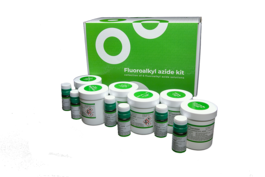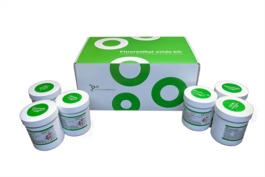Fluoroalkyl Azide Solutions
| Cat. # | Quantity | Price | Lead time | Buy this product |
|---|---|---|---|---|
| CFKIT_FAZ01 | 1 kit | 1.099,00 € | in stock |
- Name: Fluoroalkyl Azide Solutions kit
- Description: A collection of 6 fluoroalkyl azide solutions: access to a new chemical space by click chemistry. Suitable for high-throughput lead discovery technologies, such as combinatorial chemistry, synthesis DNA-encoded libraries and fragment-based drug discovery (FBDD).
- Composition: The kit provides 6 fluoroalkyl azide solutions ( FAZ001 - trifluoromethyl azide, FAZ002 - pentafluoroethyl azide, FAZ003 - difluoromethylazide, FAZ004 - trifluoroethyl azide, FAZ007 - tetrafluoropropyl azide and FAZ012 - difluoroethyl azide). The fluoroalkyl azide solutions are packed in separate vials á 5 ml which are additionally packed and sealed in PP jars.
Introduction
Fluorinated azides embody a merger of three elements that drug hunters like:
- the ubiquitous nitrogen
- fluorine that can boost efficacy
- robust and reliable click chemistry
So far, small-molecule fluoroalkyl azides eluded widespread use in life science due to their perceived unsafe nature and also due to their poor commercial availability. We are now filling this gap and offer a range of novel small-molecule fluoroalkyl azides as safe (yes, we ran various safety tests), easy-to-handle and well-defined dilute solutions.
Fluorinated azides for high-throughput drug discovery
The mildness, robustness and aqueous compatibility of the click chemistry perfectly fit the requirements placed on reactions in emerging high-throughput discovery technologies, such as DNA-encoded libraries or fragment-based drug discovery.
Want to create trifluoromethyl-, difluoromethyl-, difluoroethyl-, trifluoroethyl- or tetrafluoropropyl- containing heterocycles and amines and diversify your compound libraries?
Now there is one more way to do it.
Cu-catalyzed azide-alkyne click reaction
All fluoroalkyl azides undergo copper catalyzed alkyne-azide cycloaddition, forming 1,4-regioisomers in high selectivity.
[3+2] Azide-ketone cycloaddition
Fluorinated azidoalkanes (CF3N3, C2F5N3 and HCF2N3) undergo metal-free, enamine-mediated [3+2] cycloaddition, forming 4,5-disubstituted-1,2,3-triazoles. The reaction works well with easily enolizable ketones possessing electron-withdrawing group.
Perfluoroalkyl azides
Perfluoroalkyl azides are exotic and highly useful reagents that allow access to N-perfluoroalkyl triazoles by copper-catalyzed click chemistry and by azide-ketone cycloaddition.
N-perfluoroalkyl triazoles themselves serve as precursors that undergo Rh-catalyzed transformations with various partners, affording N-perfluoroalkyl imidazoles, pyrroles, pyrrolones and imidazolones, which are interesting, but otherwise hard-to-synthesize fluorinated drug-like motifs.
Other fluorinated azides
Most of the products in this subclass help to incorporate RCF2H moieties into a molecule. The highly polarized C–H bond of CF2H makes this group a competent hydrogen bond donor, a unique characteristic amongst polyfluorinated motifs.
Trifluoroethylation is a popular strategy in drug design to lower the pKa values of attached nitrogen heterocycles and amines, as well as improving metabolic stability of drug candidates.
Transformations of N-(per)fluoroalkyl triazoles
N-Fluoroalkyl-1,2,3-triazoles undergo various denitrogenative transformations when heated in a microwave in the presence of a Rh(II)-catalyst. The reaction proceeds through via Rh-carbenoid reactive intermediates. N-Trifluoromethyl nitrogen heterocycles, such as pyrazoles or benzimidazoles are stable towards hydrolysis unlike N-trifluoromethyl secondary or tertiary amines. These azoles display favorable medicinal chemistry properties, such as increased lipophilicity and Caco2 permeability, no reactivity with glutathione and decreased pKa, which makes them interesting building blocks in drug design. Although N-trifluoromethyl azoles are rare compounds, this moiety is starting to appear in potential drug candidates. For example, replacing the methyl substituent on nitrogen in the checkpoint kinase 1 (CHK1) inhibitor for the trifluoromethyl group resulted in suppressed N-dealkylation while keeping comparable inhibitory activity.
Not interested in N-fluoroalkyl azides? You can check our portfolio of N-fluoroalkyl triazoles with reactive handles or read more about the azides:
Explore fluoroalkyl triazoles Download technical bulletin
We continuously strive to improve our products, therefore we would like to ask you for a 5-min feedback and give you a free bonus as a reward.



